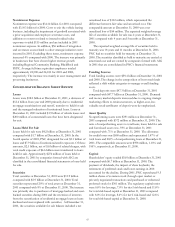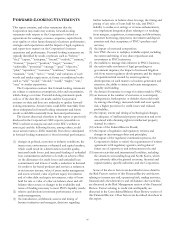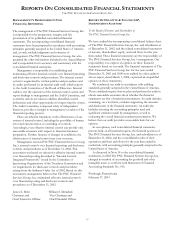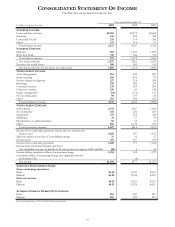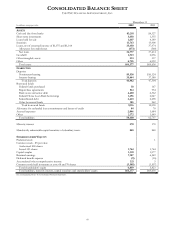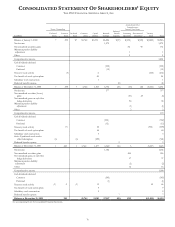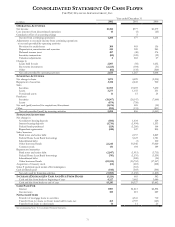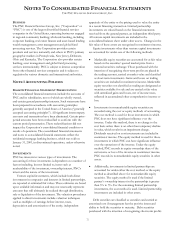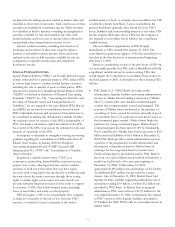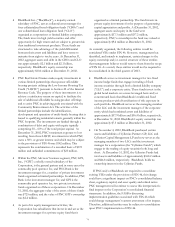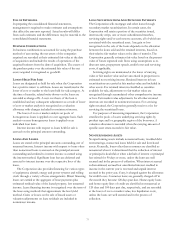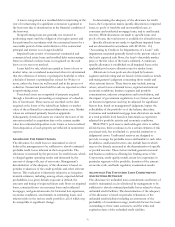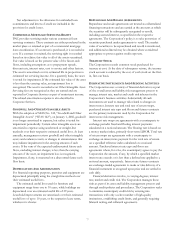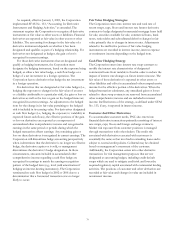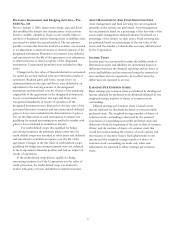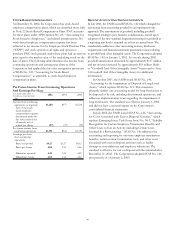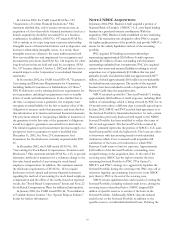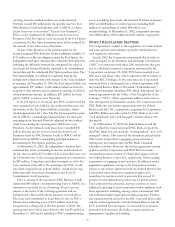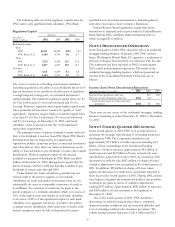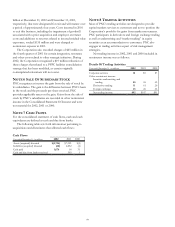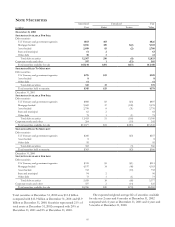PNC Bank 2002 Annual Report Download - page 77
Download and view the complete annual report
Please find page 77 of the 2002 PNC Bank annual report below. You can navigate through the pages in the report by either clicking on the pages listed below, or by using the keyword search tool below to find specific information within the annual report.75
USE OF ESTIMATES
In preparing the consolidated financial statements,
management is required to make estimates and assumptions
that affect the amounts reported. Actual results will differ
from such estimates and the differences may be material to the
consolidated financial statements.
BUSINESS COMBINATIONS
In business combinations accounted for using the purchase
method of accounting, the net assets of the companies
acquired are recorded at their estimated fair value at the date
of acquisition and include the results of operations of the
acquired business from the date of acquisition. The excess of
the purchase price over the estimated fair value of the net
assets acquired is recognized as goodwill.
LOANS HELD FOR SALE
Loans are designated as held for sale when the Corporation
has a positive intent to sell them. Loans are transferred at the
lower of cost or market to the loans held for sale category. At
the time of transfer, related write-downs on the loans are
recorded as charge-offs. A new cost basis of the loan is
established and any subsequent adjustment as a result of lower
of cost or market analysis is recognized as a valuation
allowance with changes included in noninterest income.
The lower of cost or market analysis on pools of
homogeneous loans is applied on a net aggregate basis. Such
analysis on non-homogeneous loans is applied on an
individual loan basis.
Interest income with respect to loans held for sale is
accrued on the principal amount outstanding.
LOANS AND LEASES
Loans are stated at the principal amounts outstanding, net of
unearned income. Interest income with respect to loans other
than nonaccrual loans is accrued on the principal amount
outstanding and credited to interest income as earned using
the interest method. Significant loan fees are deferred and
accreted to interest income over the respective lives of the
loans.
The Corporation also provides financing for various types
of equipment, aircraft, energy and power systems and rolling
stock through a variety of lease arrangements. Direct financing
leases are carried at the aggregate of lease payments plus
estimated residual value of the leased property, less unearned
income. Lease financing income is recognized over the term of
the lease using methods that approximate the level yield
method. Gains or losses on the sale of leased assets or
valuation adjustments on lease residuals are included in
noninterest income.
LOAN SECURITIZATIONS AND RETAINED INTERESTS
The Corporation sells mortgage and other loans through
secondary market securitizations. In certain cases, the
Corporation will retain a portion of the securities issued,
interest-only strips, one or more subordinated tranches,
servicing rights and/or cash reserve accounts, all of which are
associated with the securitized asset. Any gain or loss
recognized on the sale of the loans depends on the allocation
between the loans sold and the retained interests, based on
their relative fair market values at the date of transfer. The
Corporation generally estimates fair value based on the present
value of future expected cash flows using assumptions as to
discount rates, prepayment speeds, credit losses and servicing
costs, if applicable.
Servicing rights are maintained at the lower of carrying
value or fair market value and are amortized in proportion to
estimated net servicing income. Retained interests in loan
securitizations are carried at fair market value and included in
other assets. For retained interests classified as securities
available for sale, adjustments to fair market value are
recognized through accumulated other comprehensive income
or loss. Fair market value adjustments for all other retained
interests are recorded in noninterest income. For servicing
rights retained, the Corporation generally receives a fee for
servicing the securitized loans.
For purposes of measuring impairment, the Corporation
stratifies the pools of assets underlying servicing rights by
product type and/or geographic region of the borrower. A
valuation allowance is recorded when the carrying amount of
specific asset strata exceeds its fair value.
NONPERFORMING ASSETS
Nonperforming assets include nonaccrual loans, troubled debt
restructurings, nonaccrual loans held for sale and foreclosed
assets. Generally, loans other than consumer are classified as
nonaccrual when it is determined that the collection of interest
or principal is doubtful or when a default of interest or principal
has existed for 90 days or more, unless the loans are well
secured and in the process of collection. When interest accrual
is discontinued, accrued but uncollected interest credited to
income in the current year is reversed and unpaid interest
accrued in the prior year, if any, is charged against the allowance
for credit losses. Consumer loans are generally charged-off in
the month they become 120 days past due. Home equity loans
and home equity lines of credit are classified as nonaccrual at
120 days and 180 days past due, respectively, and are recorded
at the lower of cost or market value, less liquidation costs,
unless the loans are well secured and in the process of
collection.


